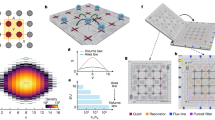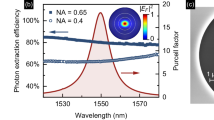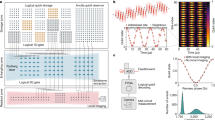Abstract
Taking advantage of quantum mechanics for executing computational tasks faster than classical computers1 or performing measurements with precision exceeding the classical limit2,3 requires the generation of specific large and complex quantum states. In this context, cluster states4 are particularly interesting because they can enable the realization of universal quantum computers by means of a ‘one-way’ scheme5, where processing is performed through measurements6. The generation of cluster states based on sub-systems that have more than two dimensions, d-level cluster states, provides increased quantum resources while keeping the number of parties constant7, and also enables novel algorithms8. Here, we experimentally realize, characterize and test the noise sensitivity of three-level, four-partite cluster states formed by two photons in the time9 and frequency10 domain, confirming genuine multi-partite entanglement with higher noise robustness compared to conventional two-level cluster states6,11,12,13. We perform proof-of-concept high-dimensional one-way quantum operations, where the cluster states are transformed into orthogonal, maximally entangled d-level two-partite states by means of projection measurements. Our scalable approach is based on integrated photonic chips9,10 and optical fibre communication components, thus achieving new and deterministic functionalities.
This is a preview of subscription content, access via your institution
Access options
Access Nature and 54 other Nature Portfolio journals
Get Nature+, our best-value online-access subscription
$29.99 / 30 days
cancel any time
Subscribe to this journal
Receive 12 print issues and online access
$209.00 per year
only $17.42 per issue
Buy this article
- Purchase on Springer Link
- Instant access to full article PDF
Prices may be subject to local taxes which are calculated during checkout




Similar content being viewed by others
Data availability
The data that support the plots within this paper and other findings of this study are available from the corresponding author upon reasonable request.
References
Lloyd, S. Universal quantum simulators. Science 273, 1073–1078 (1996).
Israel, Y., Rosen, S. & Silberberg, Y. Supersensitive polarization microscopy using NOON states of light. Phys. Rev. Lett. 112, 103604 (2014).
Hodaei, H. et al. Enhanced sensitivity at higher-order exceptional points. Nature 548, 187–191 (2017).
Briegel, H. J. & Raussendorf, R. Persistent entanglement in arrays of interacting particles. Phys. Rev. Lett. 86, 910–913 (2001).
Raussendorf, R. & Briegel, H. J. A one-way quantum computer. Phys. Rev. Lett. 86, 5188–5191 (2001).
Walther, P. et al. Experimental one-way quantum computing. Nature 434, 169–176 (2005).
Zhou, D., Zeng, B., Xu, Z. & Sun, C. Quantum computation based on d-level cluster state. Phys. Rev. A 68, 062303 (2003).
Wang, D.-S., Stephen, D. T. & Raussendorf, R. Qudit quantum computation on matrix product states with global symmetry. Phys. Rev. A 95, 032312 (2017).
Reimer, C. et al. Generation of multiphoton entangled quantum states by means of integrated frequency combs. Science 351, 1176–1180 (2016).
Kues, M. et al. On-chip generation of high-dimensional entangled quantum states and their coherent control. Nature 546, 622–626 (2017).
Yao, X.-C. et al. Experimental demonstration of topological error correction. Nature 482, 489–494 (2012).
Lanyon, B. P. et al. Measurement-based quantum computation with trapped ions. Phys. Rev. Lett. 111, 210501 (2013).
Lu, C. Y. et al. Experimental entanglement of six photons in graph states. Nat. Phys. 3, 91–95 (2007).
Knill, E., Laflamme, R. & Milburn, G. J. A scheme for efficient quantum computation with linear optics. Nature 409, 46–52 (2001).
Pysher, M., Miwa, Y., Shahrokhshahi, R., Bloomer, R. & Pfister, O. Parallel generation of quadripartite cluster entanglement in the optical frequency comb. Phys. Rev. Lett. 107, 030505 (2011).
Yokoyama, S. et al. Ultra-large-scale continuous-variable cluster states multiplexed in the time domain. Nat. Photon. 7, 982–986 (2013).
Lloyd, S. & Braunstein, S. L. Quantum computation over continuous variables. Phys. Rev. Lett. 82, 1784–1787 (1999).
Blatt, R. & Wineland, D. Entangled states of trapped atomic ions. Nature 453, 1008–1015 (2008).
Kandala, A. et al. Hardware-efficient variational quantum eigensolver for small molecules and quantum magnets. Nature 549, 242–246 (2017).
Dada, A. C., Leach, J., Buller, G. S., Padgett, M. J. & Andersson, E. Experimental high-dimensional two-photon entanglement and violations of generalized Bell inequalities. Nat. Phys. 7, 677–680 (2011).
Gräfe, M. et al. On-chip generation of high-order single-photon W-states. Nat. Photon. 8, 791–795 (2014).
Malik, M. et al. Multi-photon entanglement in high dimensions. Nat. Photon. 10, 248–252 (2016).
Barreiro, J., Langford, N., Peters, N. & Kwiat, P. Generation of hyperentangled photon pairs. Phys. Rev. Lett. 95, 260501 (2005).
Chen, K. et al. Experimental realization of one-way quantum computing with two-photon four-qubit cluster states. Phys. Rev. Lett. 99, 120503 (2007).
Vallone, G., Pomarico, E., Mataloni, P., Martini, F. De & Berardi, V. Realization and characterization of a two-photon four-qubit linear cluster state. Phys. Rev. Lett. 98, 180502 (2007).
Gao, W.-B. et al. Experimental demonstration of a hyper-entangled ten-qubit Schrödinger cat state. Nat. Phys. 6, 331–335 (2010).
O’Brien, J. L., Pryde, G. J., White, A. G., Ralph, T. C. & Branning, D. Demonstration of an all-optical quantum controlled-NOT gate. Nature 426, 264–267 (2003).
Humphreys, P. C. et al. Linear optical quantum computing in a single spatial mode. Phys. Rev. Lett. 111, 150501 (2013).
Lu, H.-H. et al. Electro-optic frequency beam splitters and tritters for high-fidelity photonic quantum information processing. Phys. Rev. Lett. 120, 030502 (2018).
Wang, X. L. et al. Experimental ten-photon entanglement. Phys. Rev. Lett. 117, 210502 (2016).
Wang, X.-L. et al. 18-qubit entanglement with six photons’ three degrees of freedom. Phys. Rev. Lett. 120, 260502 (2018).
Prevedel, R. et al. High-speed linear optics quantum computing using active feed-forward. Nature 445, 65–69 (2007).
Moss, D. J., Morandotti, R., Gaeta, A. L. & Lipson, M. New CMOS-compatible platforms based on silicon nitride and Hydex for nonlinear optics. Nat. Photon. 7, 597–607 (2013).
Pasquazi, A. et al. Micro-combs: A novel generation of optical sources. Phys. Rep. 729, 1–81 (2017).
Caspani, L. et al. Integrated sources of photon quantum states based on nonlinear optics. Light Sci. Appl. 6, e17100 (2017).
Kwiat, P. G. Hyper-entangled states. J. Mod. Opt. 44, 2173–2184 (1997).
Brendel, J., Gisin, N., Tittel, W. & Zbinden, H. Pulsed energy-time entangled twin-photon source for quantum communication. Phys. Rev. Lett. 82, 2594–2597 (1999).
Olislager, L. et al. Frequency-bin entangled photons. Phys. Rev. A 82, 013804 (2010).
Loranger, S., Karpov, V., Schinn, G. W. & Kashyap, R. Single-frequency low-threshold linearly polarized DFB Raman fiber lasers. Opt. Lett. 42, 3864–3867 (2017).
Xiong, C. et al. Compact and reconfigurable silicon nitride time-bin entanglement circuit. Optica 2, 724–727 (2015).
Lukens, J. M. & Lougovski, P. Frequency-encoded photonic qubits for scalable quantum information processing. Optica 4, 8–16 (2017).
Imany, P. et al. 50-GHz-spaced comb of high-dimensional frequency-bin entangled photons from an on-chip silicon nitride microresonator. Opt. Lett. 26, 1825–1840 (2018).
Li, X.-H. & Ghose, S. Complete hyperentangled Bell state analysis for polarization and time-bin hyperentanglement. Opt. Express 24, 18388–18398 (2016).
Einstein, A., Podolsky, B. & Rosen, N. Can quantum-mechanical description of physical reality be considered complete? Phys. Rev. 47, 777–780 (1935).
Franson, J. D. Bell inequality for position and time. Phys. Rev. Lett. 62, 2205–2208 (1989).
Browne, D. E. & Rudolph, T. Resource-efficient linear optical quantum computation. Phys. Rev. Lett. 95, 010501 (2005).
Soudagar, Y. et al. Cluster-state quantum computing in optical fibers. J. Opt. Soc. Am. B 24, 226–230 (2007).
Hein, M., Eisert, J. & Briegel, H. J. Multiparty entanglement in graph states. Phys. Rev. A 69, 062311 (2004).
Bourennane, M. et al. Experimental detection of multipartite entanglement using witness operators. Phys. Rev. Lett. 92, 087902 (2004).
Toth, G. & Guehne, O. Entanglement detection in the stabilizer formalism. Phys. Rev. A 72, 022340 (2005).
Nielsen, M. A. Conditions for a class of entanglement transformations. Phys. Rev. Lett. 83, 436–439 (1999).
Lawrence, J. Mutually unbiased bases and trinary operator sets for N qutrits. Phys. Rev. A 70, 012302 (2004).
Collins, D., Gisin, N., Linden, N., Massar, S. & Popescu, S. Bell inequalities for arbitrarily high-dimensional systems. Phys. Rev. Lett. 88, 040404 (2002).
Acknowledgements
This work was supported by the Natural Sciences and Engineering Research Council of Canada (NSERC) through the Steacie, Strategic, Discovery and Acceleration Grants Schemes, by the MESI PSR-SIIRI Initiative in Quebec, by the Canada Research Chair Program and by the Australian Research Council Discovery Projects scheme (DP150104327). C.R., P.R. and S.L. acknowledge the support of NSERC Vanier Canada Graduate Scholarships. M.K. acknowledges funding from the European Union’s Horizon 2020 Research and Innovation programme under the Marie Sklodowska-Curie grant agreement number 656607. S.T.C. acknowledges support from the CityU APRC programme number 9610356. B.E.L. acknowledges support from the Strategic Priority Research Program of the Chinese Academy of Sciences (grant number XDB24030300). W.J.M. acknowledges support from the John Templeton Foundation (JTF) number 60478. R.M. acknowledges additional support by the Government of the Russian Federation through the ITMO Fellowship and Professorship Program (grant 074-U 01) and from the 1000 Talents Sichuan Program. We thank R. Helsten for technical insights; A. Tavares and K. Nemoto for discussions; P. Kung from QPS Photronics for help and the use of processing equipment; and Quantum Opus and N. Bertone of OptoElectronics Components for their support and for providing us with state-of-the-art photon detection equipment.
Author information
Authors and Affiliations
Contributions
C.R. and M.K. contributed equally. M.K., C.R., P.R., and S.S. developed the idea. C.R., M.K. P.R., M.I., Y.Z., L.R.C., and B.F. performed the measurements and analyzed the data. S.S., C.R., M.K., L.C., and W.J.M. performed the theoretical analysis. S.T.C. and B.E.L. designed and fabricated the microring resonator. S.L. and R.K. designed and fabricated the fibre Bragg gratings. D.J.M. and A.C. contributed to discussions. R.M. and J.A. managed the project. All authors contributed to the writing of the manuscript.
Corresponding authors
Ethics declarations
Competing interests
The authors declare no competing interests.
Additional information
Publisher’s note: Springer Nature remains neutral with regard to jurisdictional claims in published maps and institutional affiliations.
Supplementary information
Supplementary Information
Supplementary Information
Rights and permissions
About this article
Cite this article
Reimer, C., Sciara, S., Roztocki, P. et al. High-dimensional one-way quantum processing implemented on d-level cluster states. Nature Phys 15, 148–153 (2019). https://doi.org/10.1038/s41567-018-0347-x
Received:
Accepted:
Published:
Issue Date:
DOI: https://doi.org/10.1038/s41567-018-0347-x
This article is cited by
-
Genetic algorithm-enhanced microcomb state generation
Communications Physics (2024)
-
Nonlinear and quantum photonics using integrated optical materials
Nature Reviews Materials (2024)
-
Entangling entanglement: coupling frequency and polarization of biphotons on demand
npj Quantum Information (2024)
-
Demonstration of hypergraph-state quantum information processing
Nature Communications (2024)
-
High-dimensional time-frequency entanglement in a singly-filtered biphoton frequency comb
Communications Physics (2023)



